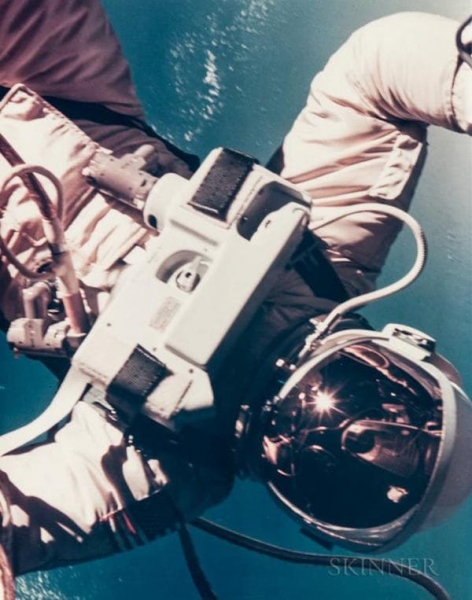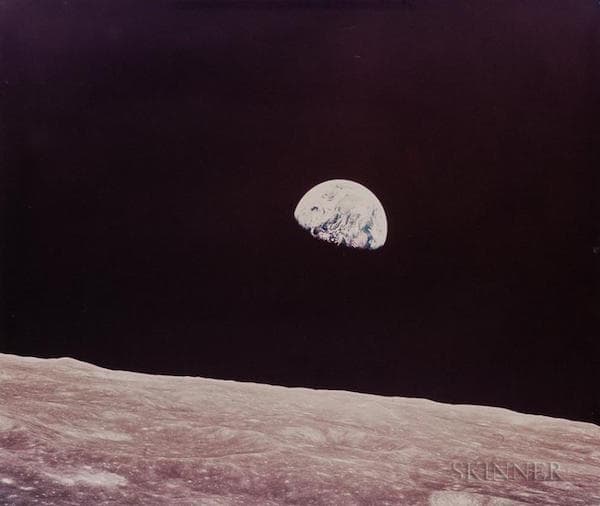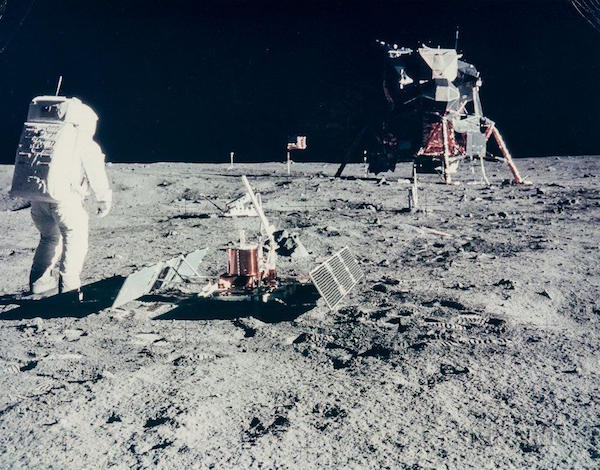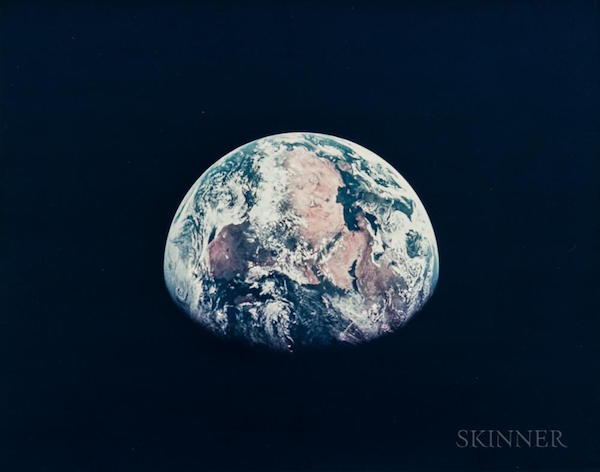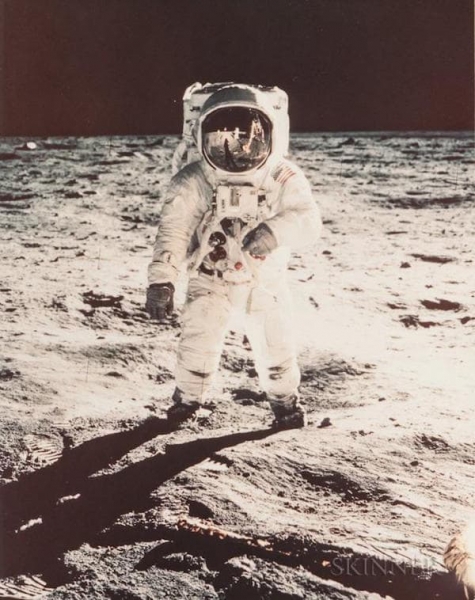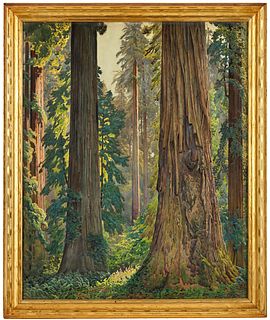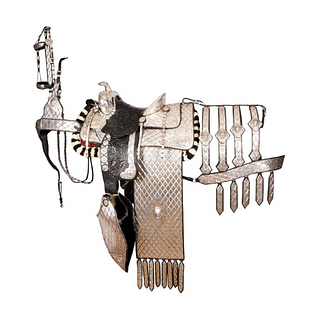To the Moon and Back at Skinner Auctions
The people of earth were busy in the summer of 1969; the Stonewall riots triggered the gay rights movement, 400,000 Americans (and their VW buses) descended on Bethel, NY for the Woodstock music festival, Charles Manson and his "family" committed a series of heinous murders and platform shoes were peeking up over the horizon. Through all of the violence and clouds of marijuana smoke, one particular event humbled them all - NASAs Apollo 11 Moon landing on July 20, 1969 and the gravity of the situation was far out, man.
On November 2, Skinner Auctions will host The Beauty of Space: Vintage NASA Photos showcasing the extraordinary photographic journey to the Moon and back as seen through the eyes of the Mercury, Gemini, and Apollo astronauts. Primarily viewed as scientific records, these NASA images clearly transcend documentation and confront ones existential understanding of life on earth. The artistic and historical impact of the selections in this catalog revisit the profound accomplishments of early space travel and magnify the serene silence of our hovering planet.
Here are some stellar examples of the upcoming photographs and their catalog descriptions bound to orbit the auction block this November:
Tethered by a looping, golden umbilical cord, Ed White moved freely 100 miles above Earth for 21 minutes. Using the guidance gun in his right hand, he maneuvered at will until its compressed oxygen ran out. He thus became the worlds first propelled space man. Though orbiting at 17,500 miles an hour, the space walker, "...had little sensation of speed and no sensation of falling, only a feeling of accomplishment." (National Geographic, September 1965, p. 440) Completely entranced by the experience, he resisted repeated calls from Houston to get back to the spacecraft. "This is the saddest moment of my life," was his response on reluctantly returning.
Lot 139, William Anders, Earthrise, Apollo 8, December 1968; Estimate $7,000 - $9,000
Prints of this size, showing the celebrated view of planet Earth rising above the bleached lunar horizon, are exceptionally rare and were very expensive to produce. The crew had completed three lunar orbits before emerging from the far side and witnessing this sight, surely one of the most astounding ever photographed. Bill Anders has described it thus: "Wed spent all our time on Earth training about how to study the Moon, how to go to the Moon; it was very lunar orientated. And yet when I looked up and saw the Earth coming up on this very stark, beat-up lunar horizon, an Earth that was the only color that we could see, a very fragile-looking Earth, a very delicate looking Earth, I was immediately almost overcome by the thought that here we came all this way to the Moon, and yet the most significant thing were seeing is our own home planet, the Earth." (Poole, p. 2)
"In my own view, the important achievement of Apollo was a demonstration that humanity is not forever chained to this planet, and our visions go rather further than that, and our opportunities are unlimited," Armstrong said in a rare public appearance to mark the 30th anniversary of the Moon landing.
"Houston, Apollo 11...Ive got the world in my window," exclaimed Michael Collins in an Apollo 11 air-to-ground transmission. After the mission, he wrote: "There is but one Earth, tiny and fragile, and one must be 100,000 miles away from it to appreciate fully ones good fortune in living in it. If I could use only one word to describe the Earth as seen from the Moon, I would ignore both its size and color and search for a more elemental quality, that of fragility. The Earth appears fragile, above all else. I dont know why but it does." (Collins, p. 471)
A "Man on the Moon," the legendary image: "What you remember of the lunar surface is more having looked at the picture over and over again, and looked and studied it. I remember more about what the Moons about because of the photographs we took that I look back on, that give me a better recollection of it than is up there (points to his head)," recalled Aldrin (quoted in Chaikin, Voices, p. 178)
Given this years unique celestial events such as The Great American Solar Eclipse, Cassinis final moments photographing Saturn and the first recording of two neutron stars slamming into each other, this catalog feels perfectly timed. In the face of political turmoil, increased super-storms and unprecedented gun violence our desire to look upward and outward at the stars seems an appropriate and defining call for solace. Experiencing a pitch-black sky in the middle of the afternoon or edging underneath Saturns rings somehow simplifies complicated answers to questions lost in the throws of our terrestrial conflicts. In the end - we are small, we are small.
Dont have a Bidsquare account? Sign up here!
Be in the know about upcoming auctions and exciting post-sale results by following us on Facebook and Instagram.

Jessica Helen Weinberg | Senior Content Editor at Bidsquare
- Quilts as a 2025 Design Trend: A Celebration of American Heritage and Craftsmanship
- A Celebration of Sports History and Collectibles
- Antiques and the Arts Weekly Q&A: Allis Ghim
- The Thrill of Sports Memorabilia Auctions: A Collector’s Paradise
- Demystifying Coin Condition: A Guide to the Sheldon Grading Scale
- Snoopy & Friends: A “Peanuts” Auction at Revere
- Colorful Chinese Monochromes at Millea Bros
- 12 Holiday Gifts for the “Impossible to Buy For” on Bidsquare
- Alluring Art Objects and Accessories from the Estate of Chara Schreyer
- Kimball Sterling's One-Owner Outsider and Folk Art Collection Showcases Masters of the Unconventional



 EUR
EUR CAD
CAD AUD
AUD GBP
GBP MXN
MXN HKD
HKD CNY
CNY MYR
MYR SEK
SEK SGD
SGD CHF
CHF THB
THB